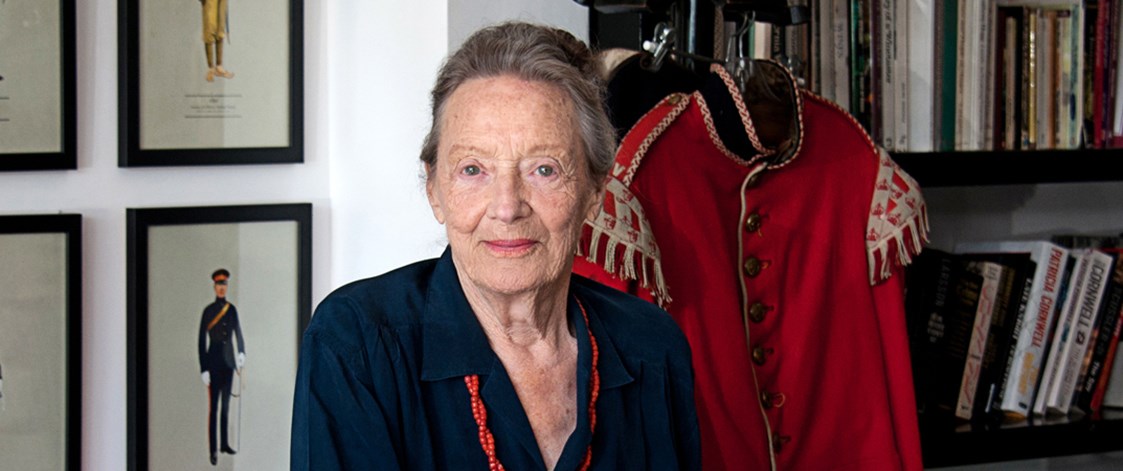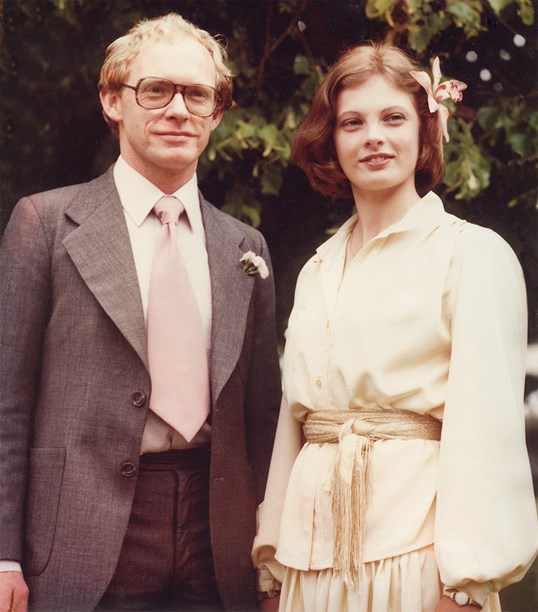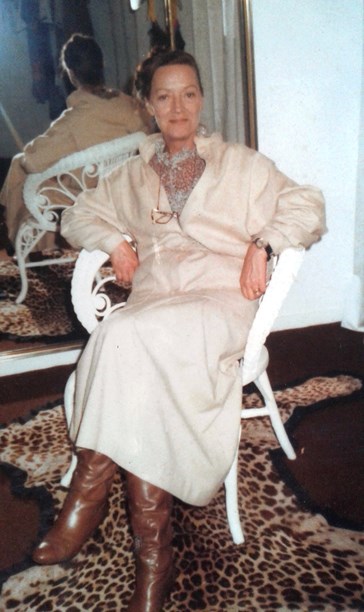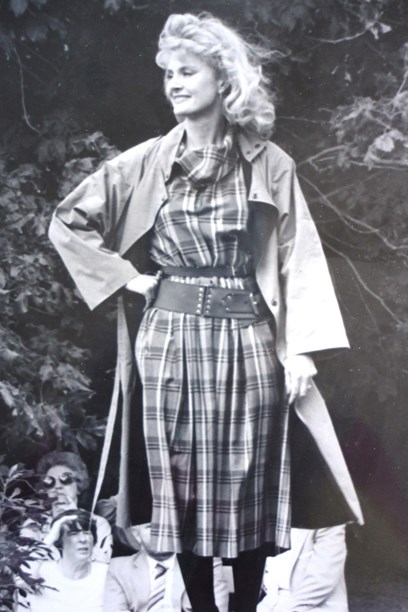Stories
Valerie Svendsen & Memsahib
1970-2012 (Memsahib)

“The art is almost as old as India —where it is called bandhnu. It is as new as the boutiques that blossom along Sunset Strip and Madison Avenue —where it is called tie-dyeing. Knotting cloth and dipping it in dye to produce patterns of colourful blobs, swirls and splotches has suddenly become a bright new fad of both high fashion and low."
Reading these words in the 26 January 1970, issue of Time magazine captured the creative imagination of Valerie Svendsen – and changed the course of her life. Taking this 'bright new fad' to the high end of the New Zealand fashion market signalled the beginning of her Memsahib fashion empire which lasted through four decades.
Valerie recalls buying industrial dyes for the silk garments that she initially supplied to a little boutique in Molesworth Street, Wellington. "I did a lot of experimenting with different methods of getting the dye to infiltrate the fabric. I’d use a shallow dish like a roasting pan to get some delicate effects. All my garments had to be stitched with silk otherwise they wouldn’t take the dye. So they looked as though they’d been cut by a master."
By 1971 demand was such that she opened the first Memsahib boutique in Tinakori Road. This was quickly followed by the flagship Memsahib in the Settlement coffee house and craft centre in Upper Willis Street – a mingling place for the Capital’s bohemians and trendsetters.

Linda Milne wore a Memsahib design when she married TV personality Kevin Milne in the 1970s.
At one stage Valerie had seven Memsahib boutiques on the go. During the affluent 1980s she opened in Lorne Street, Auckland, and briefly, in Sydney’s fashionable Paddington district. She enjoyed putting her individual stamp on her boutiques. The interiors were lush and the fittings often quirky. A Rootstein mannequin might be eyed by a large china leopard. Metal filing cabinets were enamelled pink long before the industrial 'look' became de rigueur.
Buying trips to search out the ethnic garments, fabrics, Tibetan boots, Afghan coats and Victorian-style clothing that rivalled tie-dyeing as fashion crazes of the 1970s, provided splendid adventures. Valerie recalls escaping a coup d’état in Afghanistan where she was flown out to India courtesy of a French diplomat.
French and Italian lingerie were added to her imported stock and she continued to develop her own line, keeping up with current trends as the popularity of tie-dyeing reached its peak. "I didn’t sew for the shops but I designed and chose fabrics." Valerie was an entirely self-taught designer. As well as running and designing for her boutiques she continued doing a select amount of private designing for weddings, something she’d begun during the decade or so she’d spent in Christchurch with her husband Alan who managed the local branch of the Vance Vivian menswear chain.
As her 'empire' grew, Valerie began to bring in ranges from other local designers among them Christchurch designer, Rosaria Hall, and Peter Nola’s Auckland-based Peppertree label.
The vibrant and elegant 86-year-old agrees she must have had a lot of drive during her years in business. "Well there was no reason that I thought I couldn’t do something," she muses, when asked about her creativity and confidence.
But there were hurdles. Although the 1970s had marked the surge of the women’s liberation movement, the 'girls can do anything' message hadn’t yet filtered through to the bankers and male politicians in Wellington. It was extremely difficult for Valerie as an individual and as a woman, to get an import licence. Controls were strict and licences were largely in the hands of warehouses and department stores. Fortunately a female MP who was also a good Memsahib client was able to set Valerie up with the 'right man' (whom she recalls as being somewhat greasy) and eventually she got a licence in her own name. "Also for women’s gear you paid a higher rate of duty. Why? There were some really weird things going on in those days."
As the business owner of Memsahib she was also somewhat mystified when an invitation to her bank’s Christmas party arrived for her husband. "My husband didn’t even have an account with them!" she sputters. "They thought that as their only female business client I’d be too embarrassed to attend." These memories still rankle a little. "I had no idea there was this discrimination. For heaven’s sake, my mother was the secretary of the Communist party – I’d never been given the idea the women were inferior!"
By Valerie’s account, her mother was a charming and talented woman who told stories and enjoyed reading people’s teacups. She was also busy. Valerie was the fifth of the seven McCarthy children who grew up in the Auckland suburb of Grey Lynn in the late 1930s. She was at the end of the family where the boys were. "I wore hand-me-downs and I was often dressed as a little boy," she remembers.
Much older were two glamorous sisters. To Valerie they seemed like film stars as they swished off to balls in their long gowns and high heels, with an equally elegant aunt in tow as chaperone. When backs were turned, the little sister revelled in trying on high heels and dipping into their makeup. Though her mother didn’t sew regularly, whenever she did, she would cut straight into the material without using a pattern. Valerie’s aunt (the glamorous one), was a clever designer who worked for Classic Fashions in Auckland.
Her own budding awareness of fashion design expressed itself in the making of cut-out paper dolls. "I drew them and coloured them in and even made those little tabs on their clothes. They had huge wardrobes. I kept changing their outfits for the time of the day, or whether it was their birthday – I was always making new clothes for them." Leaving Auckland Girls’ Grammar after fifth form, Valerie’s first job was in the London Book Club, a popular lending library.
At 19, she married Alan Svendsen and they moved to Wellington, setting up their first home in a small bungalow in Oriental Bay. Alan was also to have a long association with the fashion industry, working first for Schneiderman’s Suits in Wellington, and then joining Vance Vivian’s as a fashion buyer, merchandise manager and shop designer for their expanding national chain.
Valerie went to work at Whitehead and Pears, an old-style department store in Cuba Street where she excelled in display and selling, initially working in the sportswear and then the mantle departments. Around that time Valerie recalls sewing herself a skirt and top and feeling really pleased with the results. "I thought 'Hey this isn’t too hard' so I kept on doing it." This was a skill that she made good use of, sewing for others, during the next years spent in Christchurch. "Really I just taught myself from Vogue sewing patterns. I’d had an Elna (sewing machine) for some years."

Valerie at Whitehead and Pears Department Store, Cuba Street, Wellington. Photo by Fay Beyer.
Subsequent projects became more ambitious such as a wedding gown, hand stitched in guipure lace. "Many years later that bride came into my Lambton Quay shop and told me it had become a family heirloom."
Returning to Wellington in the late 1960s, she turned her hand to costume design at the fledgling Downstage Theatre. Those theatre connections brought a commission to make tie-dyed costumes for the Māori Theatre Trust performers including Inia Te Wiata, who went to Expo 70 in Japan then on a world tour.

Models from the annual fashion show that Valerie and theatre director friend Dick Johnstone used to mount as a charity event for the Te Omanga hospice in Lower Hutt. These were showy affairs held at the Prime Minister’s Hutt residence.
In 1997 Valerie and Alan moved north to Waiheke, ostensibly to retire. There they established the last shop to carry the Memsahib name. It closed in 2012, not long before Alan’s death.
There was to be one more shop – a small emporium in Surfdale stocked with what was left of the two huge containers of shop fittings, objets d’art, clothing and other collectables that had followed the Svendsens from Wellington to their island home.
Their Waiheke house is still a haven for the memorabilia and other treasures collected during almost 65 years of married life. From her wardrobe she produces a full-length pale pink Edwardian-style Memsahib outfit with exquisite hand fagotted seams and fine pleating detail inside the cuff and collar. Another object of pride is a vivid blue sequinned sheath dress with bold chevrons of fine red sequins that she designed for the Benson & Hedges Fashion Design Awards. Both had a recent outing at the 2015 Waiheke Art Gallery exhibition, Occasion: Iconic New Zealand Fashion with a touch of glamour! 1965-1975.
While the Memsahib label has an established place in New Zealand fashion history, Valerie says one of the real highlights for her was creating her 12 shops. "I was proud of the shops and I always enjoyed designing a new one," she smiles. "I’ve still got my ledger book from the very first one. Here it is, sales neatly and carefully registered. It’s really quite sweet as to what (money) I was satisfied with! Thinking back on it all, I actually had a lot of fun."
Text by Katherine Findlay. Banner image of Valerie Svendsen by Phillipa Karn.
Last published June 2016.